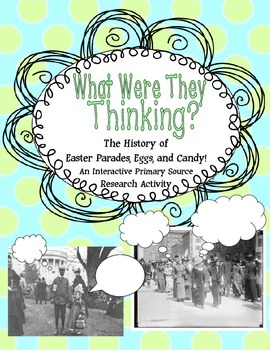Easter Primary Source Activity: What Were They Thinking?-Reading/Writing/History
- PDF
Description
Candy, eggs, and parades! Kiddos will explore these major areas while reading about the history of these important parts of the Easter holiday!
Also check out the ULTIMATE April and Easter Bundle by Clicking HERE!
Included are:
*Three articles about candy, eggs, and Easter parades.
*A note taking page for students.
*An 8 question POP quiz, asking students to use the articles they read to write solid, evidence-based answers based on the information read.
*8 primary source photographs from the late 1800s-mid 1900s.
Students will take a look at primary sources from the Library of Congress and answer the question "What Were They Thinking?" by filling in speech and thought bubbles that are embedded into each of the Easter themed pictures, photographs, and artistic representations.
On the back of each of the primary sources, students have a graphic organizer which they can fill in based on "What they see, What they Know, and What they still have questions about."
This is a student-centered, interactive activity that kids will have fun with, while also using their researching skills to discover more information on these topics.
Students will have no choice but to use their critical thinking skills during this interactive history project.
Thank you for looking!
Happy Spring and Happy Easter!





